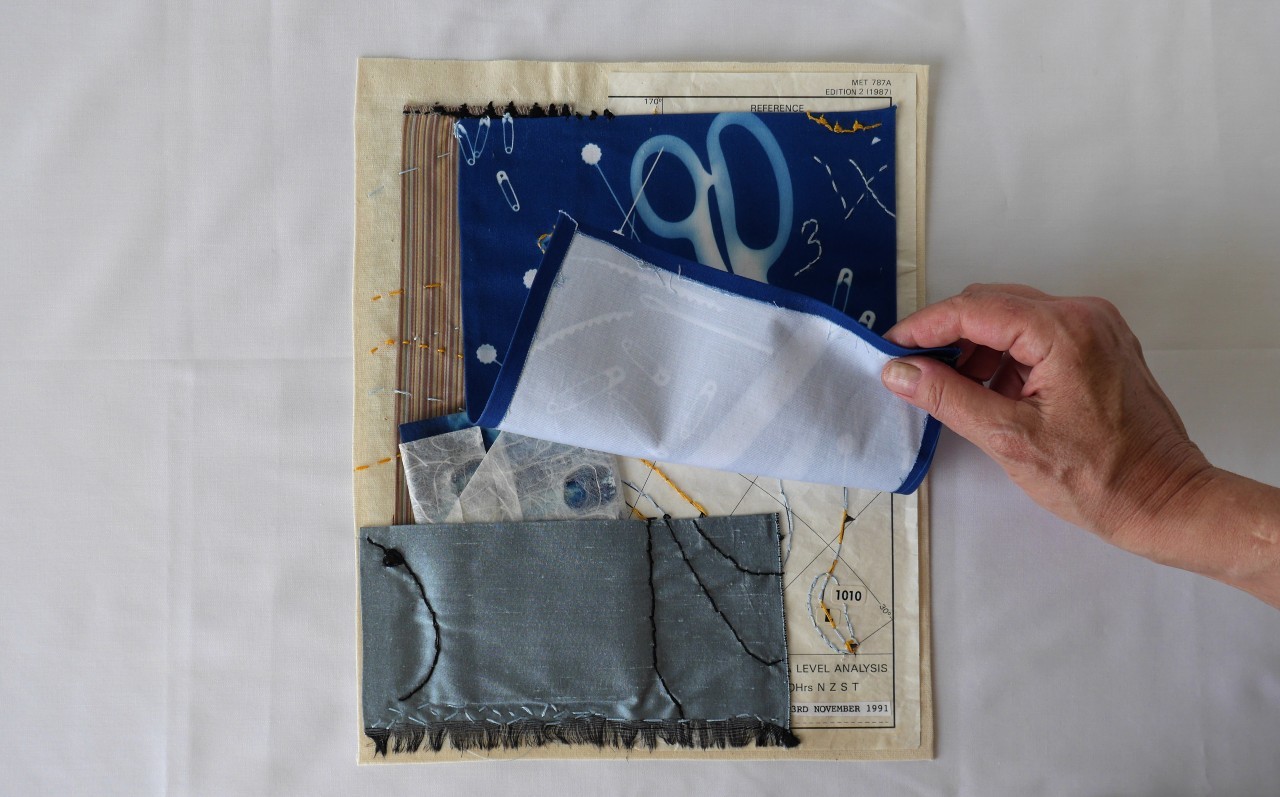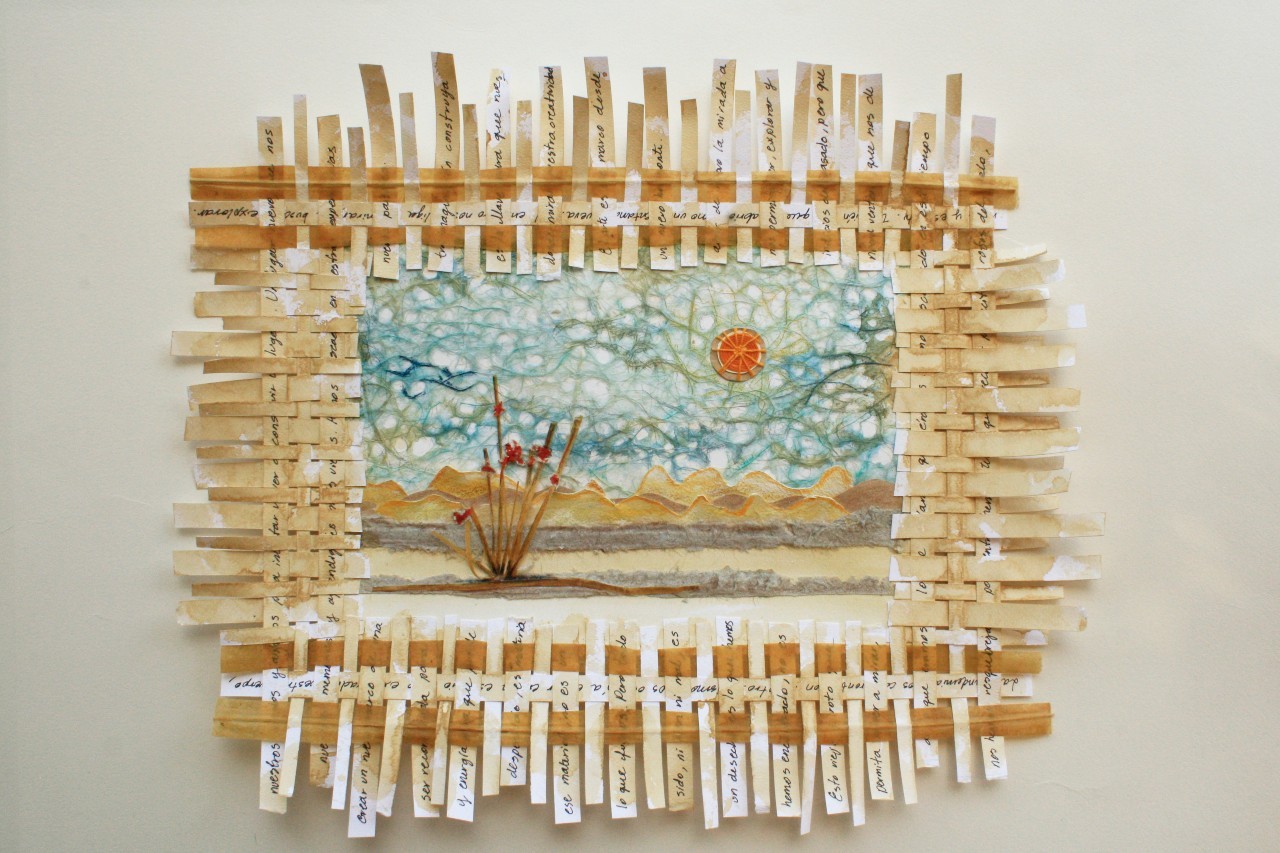Concordia Professor’s community-based art project questions the purpose of art during the pandemic
Receiving mail took on new importance during the pandemic. It became a tactile way to feel connected to other people and to the outside world. For Kathleen Vaughan, Concordia University Research Chair in Art + Education for Sustinable and Just Futures and, Professor in Concordia’s Art Education department, mail became the vehicle of exchange for an art project entitled What is art for? (WIAF).
Beginning in the summer of 2020, Vaughan mailed materials to about 100 participants in Canada, the United States and further abroad. Each individualized package included hand-made paper, assorted fabrics like silk and organza, embroidery thread and a needle to work with. She later received back 81 works: a mix of handcrafted collages, illustrations, poetry, text, as well as some digital works. All of the artworks are now documented and available to view online, with the help of graduate assistants Veronica Mockler and Tricia Enns.
In thinking about the purpose of art in a time of pandemic, Vaughan found that four types of answers emerged from the works of the contributors: breathing and embodying, honouring nature, comforting and connecting, raging and dreaming, and making change.
The project marked the end of Vaughan’s position as the Concordia University Research Chair in Socially Engaged Art and Public Pedagogies (2016-2021), and the beginning of her new Concordia University Research Chair in Art + Education and Just Futures.
In conversation, Vaughan spoke about the types of connection that can happen through art making in a pandemic, and her hopes for an in-person exhibition of WIAF.
 Artwork by Anne Pilon, made as part of the What is Art For? mail art project.
Artwork by Anne Pilon, made as part of the What is Art For? mail art project.
How did this project come about?
A lot of my work involves some kind of public engagement: meeting, making and thinking with people. I had been planning to do a mending project at Concordia where participants could bring pants to be hemmed or elbows to be patched, and my students and I who have these skills would do these little tasks for them. Suddenly in the pandemic, that project couldn’t happen for all kinds of reasons. So, I started thinking about how I can take care of people in the way I initially wanted to with that project.
The combination of that impulse and my Concordia University Research Chair in Socially Engaged Art and Public Pedagogies - one strand of which involved knitting the university into its community connections - brought me to ask: what is community now that we’re all isolated? I decided to see if people would be interested in receiving some materials from my stash of art supplies. I was happy to share and offer them as a contribution that people could use, if they chose, to create an artwork and really think about the question “what is art for?” With all these ideas percolating, I decided to send something beautiful to people through the mail.
What is the importance of mail to you and to this project?
During the pandemic, the idea of something traveling through distance between two people who are connected became extra precious. Mail is a way to connect as a surrogate for in-person connection, but also there’s a big tradition of mail art. Artists have often used the mail to exchange pieces and develop connection.
One of the things about the project is that it’s oriented toward healthy, engaged, respectful wellbeing with others. I think that mail delivery is a crucial part of that. I’m grateful that despite austerity measures prior to the pandemic, Canadian mail delivery was not completely thrown out the window and that we still have much of this crucial public infrastructure. We saw in the US how scaling back their mail delivery became a huge problem for mail-in ballots during the 2020 Presidential election and so for democracy. Hopefully, projects like WIAF can be a little wedge into the larger justice and wellbeing issues such as a basic wage for people, artists, unemployed or under employed workers, sick leave for essential workers who might not be unionized. All of these social issues are part of the solar system that this project is embedded within.
 La Ventana, artwork by Mary-Carmen Arroyo, made as part of the What is Art For? mail art project.
La Ventana, artwork by Mary-Carmen Arroyo, made as part of the What is Art For? mail art project.
What surprised you about this project?
The whole thing has been a huge surprise to me. I didn’t know what the response would be. Within a few days of my sharing the idea on Facebook, I had 100 people who wanted to participate. That was the limit of my resources, of what I could manage in terms of assembly and postage. I put together these kits, which was so much fun! I knew that I wanted each one to be different and beautiful, with a tactile richness to it, so that it would be sensorially delighting when someone opened the package. I didn’t know if people would respond to the material, how much they would use, and whether they’d even send anything back. I thought I’d get 10 responses, but I got 81. I was astonished. One of the biggest surprises was the amount of care and work that people put into their contributions. This respect for the project touched me very much and still feels like a real gift to me.
Is the project still evolving or will there be future iterations?
I’m going to have a chapter about this in a book that the Centre Sagamie and the Centre des arts actuels Skol are working on about socially engaged art in Québec. I also intend to find an exhibition venue for these works. It’s been tricky because many galleries aren’t accepting submissions because there’s so much backlog due to extended pandemic closures. We’ll see how it goes with that. So ideally, an exhibition where people can enter into a space. Hopefully that can happen at the same time the publication is launched.
Participants
Artwork by all the participants can been seen on Kathleen Vaughan's website, re-imagine.ca.
Breathing, embodying: John Doing; Zoe Compton; WhiteFeather Hunter; Josée Lavigne; Renee Jackson; Monica Brinkman; Dan Smeby; Adrienne Trent; Maher Kouraytem; Jenny QC; Molly Moldovan; Lucine Serhan; Cindy Maguire; Molly Moldovan; Catherine Heard; Anne Pilon; Heather Ryan; Claudia Coutu Radmore; Becky Frehse; Judith Boily Valois.
Animation by Marie-Pier Viens at http://re-imagine.ca/what-is-art-for/breathing-embodying/marie-pier-viens/
Comforting, connecting: Stephanie Reynolds; Maria Ezcurra; Colleen Leonard; Shaghayegh Darabi; Elsy Zavarce; Ann-Lisa Kissi; Barbara Bryn Klare; Jodie Simms; Avy Loftus; Karina Mariano; Denise A. Olivares; Rosi Maria di Meglio; Sabina Rak; Cynthia van Frank; Jeannie K. Kim; Anie Toole; Rosemary Reilly; Carolyn Weisnagel; Megan Kahnarahtenhá:wi Whyte; Kathleen Perry.
Honouring nature: Annik Arnaud; Eric Powell; Jane Zdansky; Tommy Toxic; Aileen Pugliese Castro; Fatima Abbasi; Natalie Olanick; Emma Haraké; Diana Brown; Nicole Macoretta; Nga Nguyen; Maia Iatzova; Janette Haggar; Lorrie Blair; Elise Timm-Bottos; Leila Refahi; Amélie Brindamour; Heather Margaret Ward; Judith Bauer; Lucie Lederhendler.
Raging, dreaming, making change: Marie-Lynda Bilodeau; Ching-in Chen; Shahrzad Ashadi; Marycarmen Arroyo; Jen Berger; Cyreeta Mitchell; Arianna Garcia-Fialdini; Wendy Call; Sarah Pedlow; Melissa-Ann Ledo; Petra Hoss; Pandora Hobby; Jaclyn B. Cook; Nancy Long; Marilyn Gaa; Perla Muyal; Geneviève Boisvert; Kate Madigan; Beverly Naidus; Lisa Kimberly Glickman.
Video by Marc Nerenberg; full video at http://re-imagine.ca/what-is-art-for/raging/marc-nerenberg/